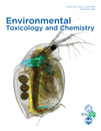Whole sediment toxicity tests for metal risk assessments: On the importance of equilibration and test design to increase ecological relevance
Whole sediment toxicity tests for metal risk assessments: On the importance of equilibration and test design to increase ecological relevance
 Current laboratory-based approaches for predicting metal toxicity in sediments exhibit a number of limitations. The most important are (1) a lack of sufficient equilibration resulting in unrealistically low pH values or unnaturally high pore water metal concentrations and (2) an inadequate test design regarding the metal concentrations selected for spiking. This study illustrates that by explicitly accounting for these limitations, one obtains reliable and environmentally realistic toxicity data, thus advancing the metal risk assessments of sediments. To this end, a toxicity test design with natural sediments was developed in which the administered metal concentrations were selected to comprise a range of [SEM-AVS] (the difference between the molar concentration of simultaneously extracted metals and acid volatile sulfides) closely surrounding zero. In addition, the presented test design includes a 35 or 40 day equilibration period with overlying water renewal during which conductivity, pH and metal concentrations in the overlying water are monitored. This allows toxicity testing to start after equilibrium for these parameters has been reached. This test design was applied to Ephoron virgo (Olivier, 1791), Gammarus pulex (Linnaeus, 1758) and Lumbriculus variegatus (Mueller, 1774) exposed to Zn and Pb. These tests indicated that the general concept of absence of toxicity when [SEM-AVS]<0 could not be rejected. However, the onset of Zn toxicity occurred at lower concentrations than generally assumed.
Current laboratory-based approaches for predicting metal toxicity in sediments exhibit a number of limitations. The most important are (1) a lack of sufficient equilibration resulting in unrealistically low pH values or unnaturally high pore water metal concentrations and (2) an inadequate test design regarding the metal concentrations selected for spiking. This study illustrates that by explicitly accounting for these limitations, one obtains reliable and environmentally realistic toxicity data, thus advancing the metal risk assessments of sediments. To this end, a toxicity test design with natural sediments was developed in which the administered metal concentrations were selected to comprise a range of [SEM-AVS] (the difference between the molar concentration of simultaneously extracted metals and acid volatile sulfides) closely surrounding zero. In addition, the presented test design includes a 35 or 40 day equilibration period with overlying water renewal during which conductivity, pH and metal concentrations in the overlying water are monitored. This allows toxicity testing to start after equilibrium for these parameters has been reached. This test design was applied to Ephoron virgo (Olivier, 1791), Gammarus pulex (Linnaeus, 1758) and Lumbriculus variegatus (Mueller, 1774) exposed to Zn and Pb. These tests indicated that the general concept of absence of toxicity when [SEM-AVS]<0 could not be rejected. However, the onset of Zn toxicity occurred at lower concentrations than generally assumed.
Full reference (link)
Vandegehuchte MB, Nguyen LTH, De Laender F, Muyssen BTA, Janssen CR. 2013. Whole sediment toxicity tests for metal risk assessments: On the importance of equilibration and test design to increase ecological relevance. Environmental Toxicology and Chemistry. Accepted. DOI: 10.1002/etc.2156.
